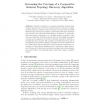Free Online Productivity Tools
i2Speak
i2Symbol
i2OCR
iTex2Img
iWeb2Print
iWeb2Shot
i2Type
iPdf2Split
iPdf2Merge
i2Bopomofo
i2Arabic
i2Style
i2Image
i2PDF
iLatex2Rtf
Sci2ools
NETWORKING
2007
2007
Increasing the Coverage of a Cooperative Internet Topology Discovery Algorithm
Recently, Doubletree, a cooperative algorithm for large-scale topology discovery at the IP level, was introduced. Compared to classic probing systems, Doubletree discovers almost as many nodes and links while strongly reducing the quantity of probes sent. This paper examines the problem of the nodes and links missed by Doubletree. In particular, this paper’s first contribution is to carefully describe properties of the nodes and links that Doubletree fails to discover. We explain incomplete coverage as a consequence of the way Doubletree models the network: a tree-like structure of routes. But routes do not strictly form trees, due to load balancing and routing changes. This paper’s second contribution is the Windowed Doubletree algorithm, which increases Doubletree’s coverage up to 16% without increasing its load. Compared to classic Doubletree, Windowed Doubletree does not start probing at a fixed hop distance from each monitor, but randomly picks a value from a range of poss...
Computer Networks | Doubletree | NETWORKING 2007 | Windowed Doubletree | Windowed Doubletree Algorithm |
| Added | 30 Oct 2010 |
| Updated | 30 Oct 2010 |
| Type | Conference |
| Year | 2007 |
| Where | NETWORKING |
| Authors | Benoit Donnet, Bradley Huffaker, Timur Friedman, Kimberly C. Claffy |
Comments (0)

